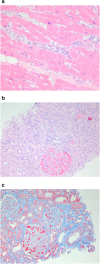Acute dilated cardiomyopathy in the setting of catastrophic antiphospholipid syndrome and thrombotic microangiopathy: A case series and review
- PMID: 35847716
- PMCID: PMC9175940
- DOI: 10.1002/jha2.71
Acute dilated cardiomyopathy in the setting of catastrophic antiphospholipid syndrome and thrombotic microangiopathy: A case series and review
Abstract
Catastrophic antiphospholipid antibody syndrome (CAPS) is a rare form of antiphospholipid syndrome, an autoimmune condition characterized by vascular thromboses, pregnancy loss, and antiphospholipid (aPL) antibodies. Diagnosis of CAPS relies on thrombosis of at least three different organs systems over 1 week, histopathological evidence of small vessel occlusion, and high aPL antibody titers. In a subset of precipitating circumstances, activation or disruption of endothelial cells in the microvasculature may occur along with cardiomyopathy. We present two cases of CAPS-associated dilated cardiomyopathy at our institution, focusing on disease management, pathophysiology, and treatment. These patients were of Southeastern Asian descent, raising the possibility of genetic polymorphisms contributing to the development of cardiomyopathy. Both met CAPS criteria and both demonstrated clinicopathologic thrombotic microangiopathy (TMA) and complement activation and developed severe dilated cardiomyopathy with shock. Complement activation plays an important role in the development of CAPS and may be important in the pathogenesis of CAPS-associated cardiomyopathy. Clinical suspicion for TMA as a pathophysiologic mechanism of unexplained heart failure in CAPS is important and increased awareness of cardiac side effects is necessary so that early treatment can be initiated to halt further cardiac and systemic complications.
Keywords: atypical hemolytic uremic syndrome; cardiomyopathy; catastrophic antiphospholipid antibody syndrome; complement; thrombotic microangiopathy.
© 2020 The Authors. eJHaem published by British Society for Haematology and John Wiley & Sons Ltd.
Conflict of interest statement
IW serves on a speakers’ bureau for Alexion Pharmaceuticals.
Figures


Similar articles
-
Antiphospholipid Syndrome and Catastrophic Antiphospholipid Syndrome: A Comprehensive Review of Pathogenesis, Clinical Features, and Management Strategies.Cureus. 2024 Aug 10;16(8):e66555. doi: 10.7759/cureus.66555. eCollection 2024 Aug. Cureus. 2024. PMID: 39252716 Free PMC article. Review.
-
Catastrophic antiphospholipid syndrome: a clinical review.J Nephropathol. 2014 Jan;3(1):9-17. doi: 10.12860/jnp.2014.03. Epub 2014 Jan 1. J Nephropathol. 2014. PMID: 24644537 Free PMC article. Review.
-
The clinical significance of low complement levels in patients with catastrophic antiphospholipid syndrome: A descriptive analysis of 73 patients from the "Catastrophic antiphospholipid syndrome registry".Lupus. 2022 Sep;31(10):1218-1225. doi: 10.1177/09612033221107583. Epub 2022 Jun 10. Lupus. 2022. PMID: 35686348 Review.
-
36-year-old female with catastrophic antiphospholipid syndrome treated with eculizumab: a case report and review of literature.Case Rep Hematol. 2014;2014:704371. doi: 10.1155/2014/704371. Epub 2014 Oct 15. Case Rep Hematol. 2014. PMID: 25389502 Free PMC article.
-
Catastrophic antiphospholipid syndrome: how to diagnose a rare but highly fatal disease.Ther Adv Musculoskelet Dis. 2013 Dec;5(6):305-14. doi: 10.1177/1759720X13502919. Ther Adv Musculoskelet Dis. 2013. PMID: 24294304 Free PMC article. Review.
Cited by
-
Case Report: Primary adrenal insufficiency due to bilateral adrenal infarction and antiphospholipid syndrome in Covid19 - A complicate case of cardiogenic shock.Front Endocrinol (Lausanne). 2025 Apr 2;16:1554009. doi: 10.3389/fendo.2025.1554009. eCollection 2025. Front Endocrinol (Lausanne). 2025. PMID: 40241990 Free PMC article.
References
-
- Makatsariya AD, Khizroeva J, Bitsadze VO. Catastrophic antiphospholipid syndrome (Ronald Asherson syndrome) and obstetric pathology. J Perinat Med. 2018;46(4):387‐400. - PubMed
-
- Espinosa G, Bucciarelli S, Asherson RA, Cervera R. Morbidity and mortality in the catastrophic antiphospholipid syndrome: pathophysiology, causes of death, and prognostic factors. Semin Thromb Hemost. 2008;34(3):290‐4. - PubMed
-
- Galli M, Finazzi G, Barbui T. Antiphospholipid antibodies and associated clinical manifestations. Hematology. 1996;1(2):125‐32. - PubMed
LinkOut - more resources
Full Text Sources
Miscellaneous
